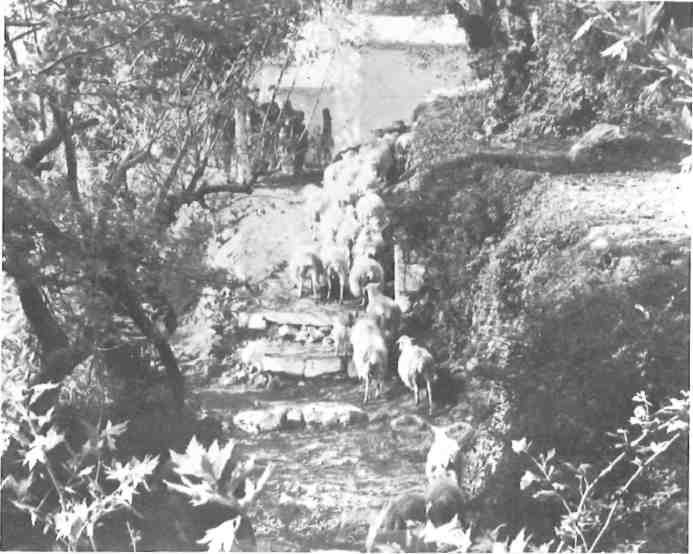The blessing of the sheep in Asi Gonia is one of the oldest Cretan festivals. It is celebrated on the feast day of Saint George when the herds are brought from the lower winter pastures to be blessed before they are led to higher summer pastures on the mountain. Dating back to pre-Christian times, the festival has evolved into the present-day ceremony which takes place annually at the chapel of Saint George in the small village located in the foothills of the Sfakia range. It is easy enough to get to Asi Gonia: less than a half hour’s drive from Rethymnon, it is about two hours from Iraklion and a little over an hour from Hania.

Saint George’s Day is normally celebrated on April 23, but when Easter is later, the Saint’s day and the festival are postponed until Easter Monday. It will be observed this year on April 26. Almost every house in Asi Gonia has a George; the individual celebrations of their name days adds considerable intensity to the festival. Thus it is the occasion for a great paniyiri, of unlimited and lavish hospitality, of vitality coupled with the simple morning services. The tavernas and the platia throb with lyra music and dancing raised to a high pitch in this village known for its musicians and dancers. There is continuous feasting — with lamb gracing the table and with much drinking of wine, ouzo, and the near-fatal drink of the region, tsikoudia.
Last year we left Hania before dawn for the sheep-blessing ceremony. Taking the National Road, we passed through the rose gardens and drove into the countryside which in the spring is brilliant with fields of scarlet poppies and golden daisies. At a clearly marked sign, we turned off the National Road and travelled a short distance along a country road until we arrived at a spot conspicuous for its suddenly dense lushness in an already luxuriant ambiance. This is a place to stop for a drink of sharply-cold water and to take a stroll. On the hills above, open aqueducts carry water down to the valley. Wide, tree-lined steps lead upwards and the ascent is made between carefully laid out, winding runnels of water. At various levels are large, man-made ponds, their still surfaces reflecting the branches of the mulberry trees that lean over them. It is like a piece of the Alhambra incongruously set down in the Cretan countryside. Near the top, a minute chapel is built into a cave. It is not far from here to Asi Gonia.
Dawn was breaking over the village when we arrived. Herds of sheep and goats dotted the hillside on which Asi Gonia is built. The sound of bleating, clanging bells, and shouts and whistles from the shepherds filled the air. Herd after herd was driven through a ravine near the main platia and up to the chapel of Saint George. With spindly legs and coats still shaggy from winter, the sheep stood in docile groups as the priest moved among them, blessing them with holy water sprinkled from a sprig of basil tied to a cross. As each herd moved on, the priest returned to the chapel to continue the service only to re-emerge as a new herd arrived.
Once blessed, the sheep were driven into a corral and milked, the festival’s rowdiest event. In a confrontation between protesting sheep and determined shepherds, the animals were straddled, milked and led off to higher pastures as cauldrons of foaming fresh milk were lugged away. Everyone had a job: barefoot boys chased strays; old men, experienced but no longer nimble, kept their trained eyes and handy crooks in constant action.
We left the. ceremonies for a time and wandered up through the town where we were greeted by a very old villager sipping his coffee at a kafenion. He wore the costume of all older men of this area: high black boots, black baggy pants, black shirt, vest and wide sash, and a crocheted head covering. He asked us to join him.
He said he was one hundred years old. A member of his family nearby said he was ninety-two. ‘It’s the same thing,’ the old man commented.
I asked if he had always been here for the sheep blessing festivals. He held his hand just above the ground to indicate that he had since he was a baby and then added that so had his father before him, and his father’s father, and so on back into time.
Later we stopped at the house of George Psyhoundakis, whose well-known diaries from his youth during the war have been translated into English as The Cretan Runner. His wife, Sofia, brought out tsikoudia on a tray with glasses of water. We sat under a grape arbor in the drowsy sound of nearby beehives, emptying our quickly refilled glasses and talking, within sight of the chapel and the great ebb and flow of sheep. Clouds were massing from the direction of the sea. But soon that changed, too, as the sky constantly does on this island equidistant from Africa, Asia, and Europe.
Returning to the chapel we lit our candles. In the midst of the green and rocky countryside, the bleating of the sheep, the antiphony of their clanging bells, the chanting from the chapel, and the odour of incense invoked a timeless quality.
The sheep’s milk had been blessed. We filled our cups and accepted chunks broken off from enormous wheels of bread that had been blessed and passed around. In that setting, it was all one really wanted at that moment. The festivity, which had begun the night before, resumed.







